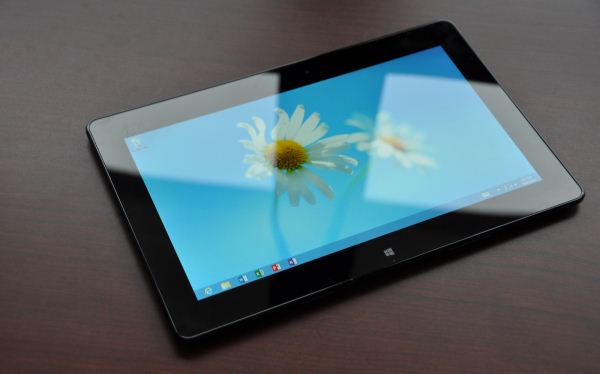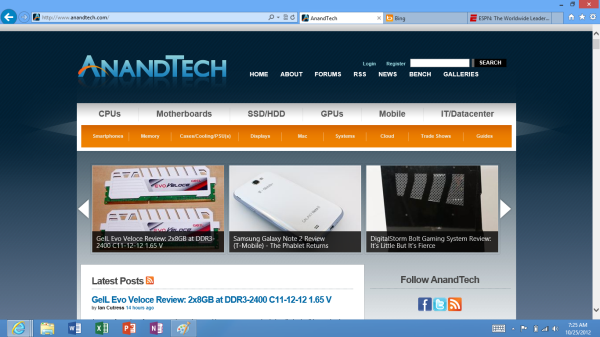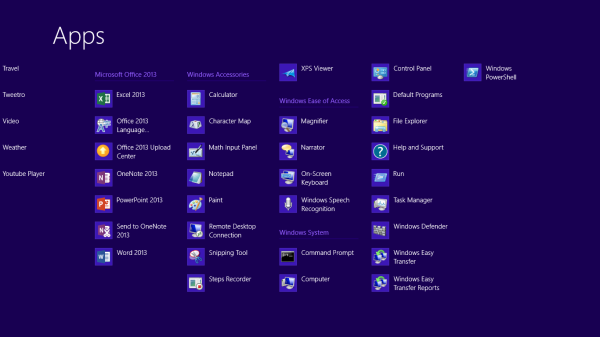The Windows RT Review
by Vivek Gowri & Anand Lal Shimpi on October 25, 2012 12:00 PM EST- Posted in
- Windows RT
- Operating Systems
- Microsoft
- Mobile
- Windows 8
- Tablets
Bridging the Gap, the Dichotomy of Windows RT
by Anand Shimpi
I described Windows RT as being a tablet OS with all of the underlying Windows-ness of Windows. You can get the big full screen app experience in tablet mode, but poke around your file system with Explorer or use Office 2013 like you would on a traditional notebook if you want to. If the two sides of Windows RT remained fairly separate that’d be one thing, unfortunately there are some dependencies between the two sides of the OS that keep the overall user experience from being as friendly as it is in iOS. There are still occasional reminders that you’re dealing with something that’s distinctly Windows here.
Most mobile OSes have done their best to hide the underlying file system and shell from the end user. Microsoft did, in my opinion, the smart thing and avoided hiding its roots with Windows RT. Although the new Start Screen is the default UI for Windows RT, there’s a big desktop tile front and center that will take you back to something far more familiar:
Unlike the Windows 8 desktop, you’re pretty limited in what you can do here. The only applications that are allowed to run in desktop mode under Windows RT are Explorer, IE10, Office 2013 and the command prompt (there are also all of the Windows specific tools and settings which I’ll get to shortly). Developers cannot make applications for Windows RT desktop mode and you can’t sideload anything here. Microsoft’s belief is that by completely locking down the system, requiring that applications only come from the Windows Store, it can avoid the pitfalls of viruses and malware that can plague Windows machines today.
Steve Sinofsky famously quoted an analyst when they asked if Windows RT would be backwards compatible with all of the legacy Windows viruses and spyware. The answer was an astounding no, and this is exactly why we can’t have open season on Windows RT desktop development. There’s also the obvious financial angle to all of this. Microsoft takes a cut of any apps sold through the Windows Store.
Coming from the perspective of a traditional Windows user, the lack of flexibility on the desktop seems wrong. From the perspective of the rest of the ARM based tablet space, it’s not a big deal. At least Windows RT gives you direct, first party access to the file system. There’s very little exposed through iOS, and with Android you need to download a third party app to get access to the file system.
Explorer works just as it would on a Windows 8 PC. The folder structure is exactly as you would expect it on any Windows machine. There are even some x86 remnants in the Windows RT install such as a C:\Windows\SysWOW64 directory complete with x86 binaries inside that obviously won’t run on your Windows RT tablet.
Internet Explorer in desktop mode works just like a traditional IE windows application would work. The desktop app actually controls settings and features for the Metro...err...fancy IE10. For example, if you want to change security settings, clear your history or empty your cache, you have to do all of these things from the IE10 desktop application. Fancy IE10 doesn’t expose them.
The command prompt is, well, a command prompt. It features all of the same commands that you could run before, although once again you can’t simply drop an x86 exe on your system and run it. Not having binary compatibility can be frustrating at times.
Although developers can’t build applications for Windows RT’s desktop, you can write and execute batch files. Keep in mind that if your batch file needs any additional support files (e.g. sleep.exe) you’ll need ARM versions of them which, unless they come from Microsoft, just isn’t happening.
As I mentioned earlier, there are a few other things you can run and do in RT’s desktop mode. Control Panel, event viewer, disk management and all of the other administrative tools that you’d expect to come with Windows are present in Windows RT (including regedit). There are also the little apps that Microsoft has always included, which also work in desktop mode (e.g. mspaint, calc, notepad, etc...)
Ultimately Windows RT is an ARM version of Windows with tablet makeup on. You still get all of the normal bits and pieces of Windows, minus some flexibility and of course, backwards compatibility.
For years we’ve been asking Microsoft to make a clean break with its legacy code and introduce a version of Windows that was built from scratch, with only support for the latest hardware. With Windows RT, Microsoft finally delivered some of that, but in a sort of weird, backwards way.
As Windows RT only supports the ARMv7 instruction set architecture, none of your old x86 applications will run on the platform. Microsoft hoped to avoid this being a problem by shipping an ARM version of Office 2013 Home & Student Edition with Windows RT tablets, and by directing users at the Windows Store for the rest of their application needs. Although it would’ve been possible for Microsoft to enable x86 compatibility through emulation or binary translation, performance would’ve likely been pretty bad.
The loss of backwards compatibility with years of Windows applications feels wrong, but from Microsoft's perspective you don't get that with iOS and Android so there's no real competitive disadvantage here. Why bother with an ARM based version of Windows to begin with? To bring competition to Intel and ensure that it will be able to deliver Windows to the new wave of ultra mobile devices (e.g. tablets). Intel hasn't been competitive on power or pricing at the low end (read: Atom) of the spectrum for years now. The introduction of Windows RT changed that. Atom Z2760 (Clovertrail) is around half the price of the cheapest Atom CPU of the past five years, and it's price competitive with solutions from Qualcomm. We have Windows RT to thank for that. Without pressure from ARM, Clovertrail would've started around $50 per chip just like Intel's low end parts had in the past. As AMD is no longer a pricing check for Intel in some of these new markets, Microsoft had to look for a new way to offer balance. Supporting ARM is its way of doing that. Until there's a new pricing/power/performance x86 competitor to Intel in tablets, ARM and Windows RT will remain.














233 Comments
View All Comments
steven75 - Friday, November 2, 2012 - link
Yes, agreed 100%. This review seems to be by far the most certain the *metro* apps are going to grow by leaps and bounds than any other review I've read. I think there's definitely a chance RT and thus metro apps aren't going to take off at all.karasaj - Thursday, October 25, 2012 - link
Forgot to say thanks, great review! I was wondering about the smoothness of Surface etc - it doesn't seem like there will be much to worry about. Thanks again!nedjinski - Thursday, October 25, 2012 - link
Thanks for yet another sane and unbiased review. I find this approach the most helpful when considering a new purchase. You guys continue to have clear vision when it comes to the big picture and you don't get distracted by small details that will probably get ironed out in future iterations of the device.It looks like MS has a winner here.
Netscorer - Thursday, October 25, 2012 - link
While this is an overall very good and comprehensive review, I am still confused by two separate Windows 8 OS (with Windows Mobile 8 may be third). I just don't see how they are going to coexist long term. And if there will be convergence, which OS will be left out.I was hoping review would touch on those issues a bit more then spending page after page describing various apps that come built in and will undergo a significant change/enhancement shortly anyway.
haukionkannel - Thursday, October 25, 2012 - link
Well the Metro UI aplication will be very popular in Mobile platforms. Because both windows 8 versions can run those, there is no problem in there. If you want to run normal desktop application, video editing, AAA games, the normal 86 version of win8 is for you.If you have to chose between normal win8 and win8 RT pad, or tablet there is not very big difference. In most cases it is better for programmers to make Moder UI version of their program than to make only Intel CPU based version that runs only in normal win8 version. Thre will be more customers in Modern UI platform than normal. So instead of having bottle neck with old gaming consoles, the new botleneck will be the slovest win8 RT pad in most cases.
If you are serious gamer the normal win8 is for you. If you are interested in just getting pad for playing casual games like Angry bird, and reading www-pages, listening music, looking viodeos, etc, it does not matter what you get, if the price is good and ahrdware desent.
AmdInside - Thursday, October 25, 2012 - link
Waiting for MAME to be available for either Windows RT or Windows 8 before I buy a tablet.ludikraut - Thursday, October 25, 2012 - link
Oh yeah, MAME on a tablet will rock.l8r)
jecastejon - Thursday, October 25, 2012 - link
I am interested, reading and taking notes but is this Windows RT a netbook-nettop OS at a higher price point?I think I will wait at least 2-4 years to consider an ARM-Atom based computer to produce even some light work, as for a device to have fun there are tablets, Nintendo, PSP, iDevices with thousands of apps or games. WRT is not that cool, it does nothing better as an entertaining system but it may be great to produce very light or limited work on the office and just probably on the go but even for that it will need to compete with entry-laptops and ultralight machines.
Right now this is a very hybrid concept targeting for a broad marked but I just can see a niche market I am sure it will reach. I think in part the price is to high and it will be kind of a business ultra light high end system.
diamondsw2 - Thursday, October 25, 2012 - link
"85% (or more) of computers being sold worldwide"I assume you're not including iPad sales - which is very misleading for a tablet OS review. And if you're more broadly talking Windows 8 all of a sudden (RT != 8), the overwhelming majority of Windows sales are to businesses - and those businesses are going to exercise their downgrade rights and not touch Windows 8 with a ten-foot pole. There's no business case for it over Windows 7, and the training is far from insignificant. It's not going to get any headway there for years.
Consider be very skeptical on actual uptake of Windows 8 or its supposed marketshare. I'll bet it's six months to a year before I see the first person using it (which may say more about how many of my PC-using friends have converted to iPads and Macs). I fully expect every Windows PC I see to be on 7 for a long time to come).
PsychoPif - Thursday, October 25, 2012 - link
Just from a quick search, I've found that Apple sold 15.4m IPad vs 49.8m for the top 4 OEM. It does'nt include the other manufacturer and it's still 70% marketshare.85% might be high, but don't make it sound like Windows won't be on the vast majority of computer sold this year.